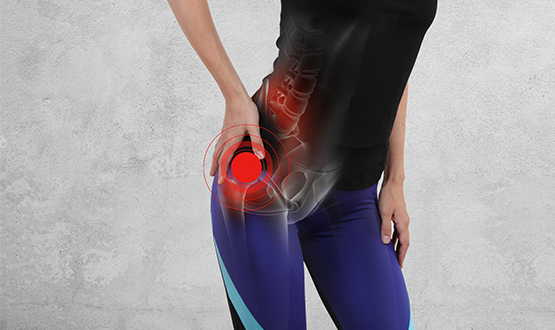Overview
The hip is one of the most stable joints in the body. But because it bears your body weight, it is more likely to develop arthritis and other degenerative diseases because of the extra pressure.
It is actually a ball-and-socket joint where the femur (thighbone) meets the pelvis. The top of the femur has a rounded head that fits into a cup-like socket in the pelvis called the acetabulum. When the hip joint is healthy, it moves smoothly and effortlessly, enabling activities like walking and sitting without discomfort. However, issues such as injury, arthritis, or ageing can lead to pain, stiffness, and limited mobility in the hip joint. It's crucial to consult with a healthcare professional for proper diagnosis and treatment based on the specific nature and severity of the hip injury.

Common Causes of Hip Pain
Hip Fracture
A break in the hip bone, often caused by falls in older adults or high-impact accidents.
Hip Dislocation
Displacement of the hip joint's ball and socket, typically resulting from severe trauma.
Hip Bursitis
Inflammation of the bursae (fluid-filled sacs) around the hip joint, causing pain and discomfort.
Hip Tendonitis
Inflammation of tendons around the hip joint, commonly due to overuse or repetitive stress.
Hip Arthritis
Your hip pain may be caused by chronic swelling or inflammation in the joint, commonly known as arthritis. The two most prevalent types of arthritis associated with hip pain are osteoarthritis and rheumatoid arthritis.
- In osteoarthritis, often referred to as wear-and-tear arthritis, the protective cartilage at the end of the femur may have worn away, leading to painful bone-on-bone rubbing during walking.
- In rheumatoid arthritis, also known as inflammatory arthritis, the immune system mistakenly attacks the joints, resulting in uncontrolled inflammation, pain, and potential joint erosion.
Hip Impingement
Hip impingement, also known as femoroacetabular impingement (FAI), is a condition where the bones of the hip joint do not fit together properly, resulting in abnormal contact and friction during hip movements, which can cause pain and restricted movement.
FAI that occurs due to the overgrowth of bone on the thigh bone (femur) is known as cam impingement, whereas excess bone on the pelvic side, which grows and extends out over the normal socket of the hip (acetabulum), is known as pincer impingement. While cam impingement is the most prominent, many patients have a combination of both types.
Hip Labral Tears
A tear in the labrum can occur due to a significant injury like a hip dislocation or from repetitive use. Many individuals with impingement are also susceptible to labral tears. This tear in the labrum could be contributing to the pain you are feeling.
Avascular Necrosis (AVN)
In this condition, the femoral head (the ball portion of the femur, or thigh bone) loses a substantial portion of its blood supply and starts to die. This makes it weaker and unable to withstand the regular pressure of activities like walking and climbing stairs, causing it to become increasingly deformed. AVN has been linked to alcoholism, fractures and dislocations of the hip, and long-term steroid treatment for other diseases. In some cases, no cause can be identified.
Struggling with hip pain? Explore the available treatments for your hip pain here


